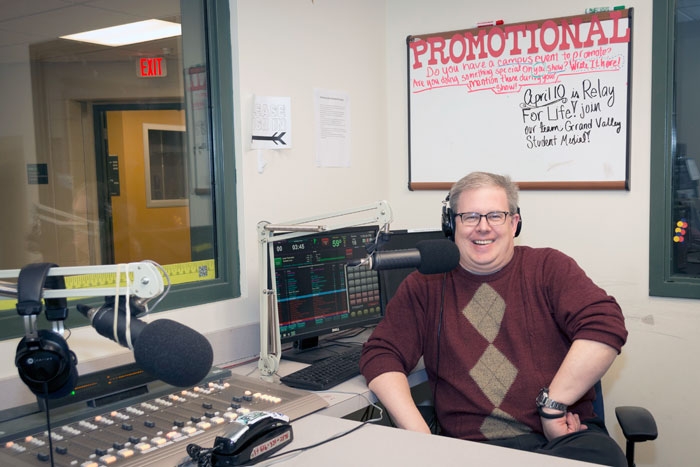For almost a decade, radio station WSRX broadcasted from the basement of the student center at Grand Valley State University — then Grand Valley State College. Lore has it that one enterprising and curious young man once took a hit or three of LSD and put in a 48-hour stint as deejay.
He was one of the responsible ones at the student radio station.
From the mid-70s until 1982, Grand Rapids had a genuine underground station in WSRX, although you could barely hear its 10 watts much past Standale. DJs routinely missed their shifts if the party they were at was really happening, whole album sides were played, and pot was smoked.
It was a renegade station that made WKRP look like WJR.
But when the FCC ruled that stations could no longer operate on just 10 watts, Grand Valley’s leadership decided it might be a bad scene for anyone other than the locals to hear the free-form radio with the college’s name attached, and the station became an NPR-simulcast station now known as WGVU-FM, or more precisely, ESTABLISHMENT-FM.
Student radio at the area’s largest university was dead, sunk by Garrison Keillor and Mahler. Mozart would be repulsed by the cowardice that “student” radio in the Valley became.
Grand Rapids radio has always been a step ahead on the commercial airwaves because of WLAV, considered by many a premier FM station all the way through the ’70s. You could hear a B-side from Patti Smith’s Horses LP segueing into Pink Floyd’s 23-minute “Echoes.”
Today, the cutting edge is led by WYCE, 88.1, a community station staffed by mostly volunteers — there’s no money in playing the real deal anymore. There’s a smattering of specialty stations with faith-based programming. Most of the waves have for decades been dominated by the dull conformity of conglomerates. Cumulus owns WLAV, which on occasion defies the odds with a deep track. Clear Channel, now iHeartMedia Inc., owns a bunch of stations.
Meantime, downstairs at the student center at Grand Valley, there is a renaissance of sorts. No one’s tripping balls at the control board these days, so don’t get too excited.
But after the public radio sellout, the four-room studio that once housed WSRX for years languished and Grand Valley stopped offering classes in radio.
Len O’Kelly came along with 25 years of radio experience — a lot of it in Chicago, the nation’s third largest radio market. He grew up in the shadow of the WLS tower, “so close that I heard it in my phone,” he says.
Radio imbued his spirit. He jumped around as most media people do. Itinerant by necessity, bouncing around to: Davenport, Iowa; Joliet, Ill.; Springfield, Ill.; Chicago in 2007; and now Grand Rapids.
O’Kelly began programming oldies at the university’s AM station, WGVU in 2009. In 2010, he began advising the kids at the station and proposed a radio class, the first in years at the college.
“At that time, the station here in the basement was just a club,” says O’Kelly, 46, sitting in the main broadcast studio on a Friday afternoon in March. “Six kids came in and did shows on WCKS, which is what WSRX became, for no one.”
The administration didn’t think the class would sail. It drew 13 students the first semester. This year, 18 signed up to look into making radio a career, making it a full class.
On Tuesday nights, Kyle Callaghan runs a talk show on WCKS, which is Internet only for now.
“It’s mostly talk with some music in between,” he says. He’s a junior from Grand Rapids and his future will be “anything in broadcasting.”
Ditto Jeana Gondek, who’s the news director at WCKS and also produces the morning show at WOOD-AM.
“I can’t think of doing anything else but radio,” Gondek says.
But what about the notion of having a career with the same future as a typewriter mechanic?
“The Internet will keep radio alive,” she says. “So many people are now listening to radio with apps, and that will keep growing.”
WCKS is not the reckless, adventurous blast of past college radio that is being kept alive by stations like Western Michigan University’s WIDR and Rice University’s online station, KTRU. Instead, the station plays from a rotation of 5,000 songs that includes acts like Eminem, the Doobie Brothers, Jay Z, Shakira and Springsteen. It’s a mainstream listener’s dream and a purist’s nightmare.
“When there was college radio in the ’80s, you had this limited spectrum,” O’Kelly says. “Now you have 50,000 stations you can get on the Internet. They want to be heard, so if the public wants to hear Katy Perry, you better play Katy Perry.”
That sounds like the talk of a sellout, but it’s more about making his radio devotees ready for a job.
“Because kids are making such an expensive investment in education, they need to be able to pay off their loans when they graduate,” O’Kelly says.
Sadly true. The airwaves of Grand Rapids and cities across the U.S. are filled with the big business end of life, from corporate talk to corporate rock.
O’Kelly is keeping alive a science that’s been called a fading livelihood, a passé art/business relatively few will dare to love.
“There is every reason this shouldn’t be happening, yet we have this (student station) with this constant activity,” O’Kelly says. “People keep saying radio is dying, that young people are not interested in radio. It’s not true.”
As such, he sees no sign of a sign-off in the future.





